12 Types of Email Marketing Every Marketer Should Know
We’ve talked a lot about email marketing on our blog over the years, and for a good reason.
Email marketing is one of the most effective, tried-and-true digital marketing techniques we have today, and it should be a staple in your digital marketing strategy.
Here are the twelve types of email marketing campaigns you should know and use in 2023!
12 Types of Email Marketing (By Use Case)
If you want to start at the very beginning, we suggest you check out our all-encompassing guide on email marketing to discover what it is and what it entails.
If you’re already running various email marketing campaigns, however, then you’re ready for some advanced tips and different types of email to spice up your marketing efforts.
We can divide the different types of email marketing campaigns into three distinct categories:
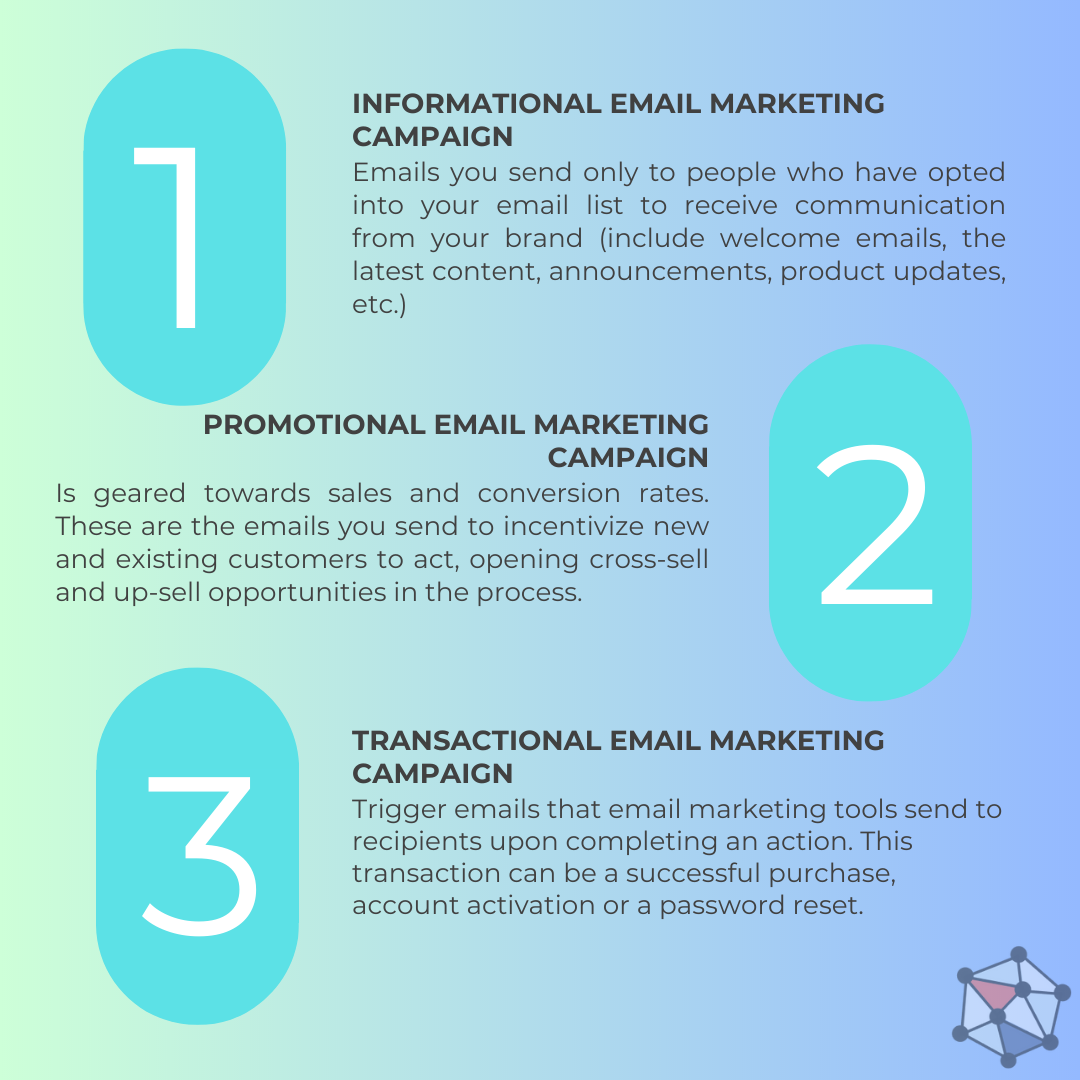
Now that you have the essential info on these different types of emails, let’s delve deeper into each.
Also, don’t forget to check out these 28 email marketing examples to get inspired when designing your emails and writing a compelling copy!
Informational Emails
Informational emails are those you send only to people who have opted into your email list to receive communication from your brand. These emails can include welcome emails, the latest content, various announcements, and product updates.
Use this email type to build brand awareness, onboard customers, and engage new email subscribers. You can also send brand pitch emails when you’re looking to partner up with another company, providing information about your brand and services.
All types of email marketing are equally important for a growth-oriented business, mind you, but they serve different purposes. The great thing about informational emails, however, is that they are relevant at every stage of the sales funnel.
From lead nurturing emails to customer onboarding, all the way to maintaining brand awareness in the hearts and minds of long-term customers, this email type is crucial in your email marketing strategy.
Here are the informational emails you need to be sending out.
Type #1: Welcome emails
For most businesses, regardless of the industry or niche, pushing a sales-oriented narrative as soon as you obtain a new email address won’t get you very far. In fact, it might throw the prospect off and is, therefore, not a good way to improve your open rates.
That’s why welcome emails are an essential part of the customer onboarding process for your brand. In practice, a welcome email has good deliverability and allows you to nurture a lead with a drip campaign complemented by a personalized email message.
There are many ways you can style and structure a welcome message, but here is a great example from Revolut, a popular online bank, that we think is just right for a first email:
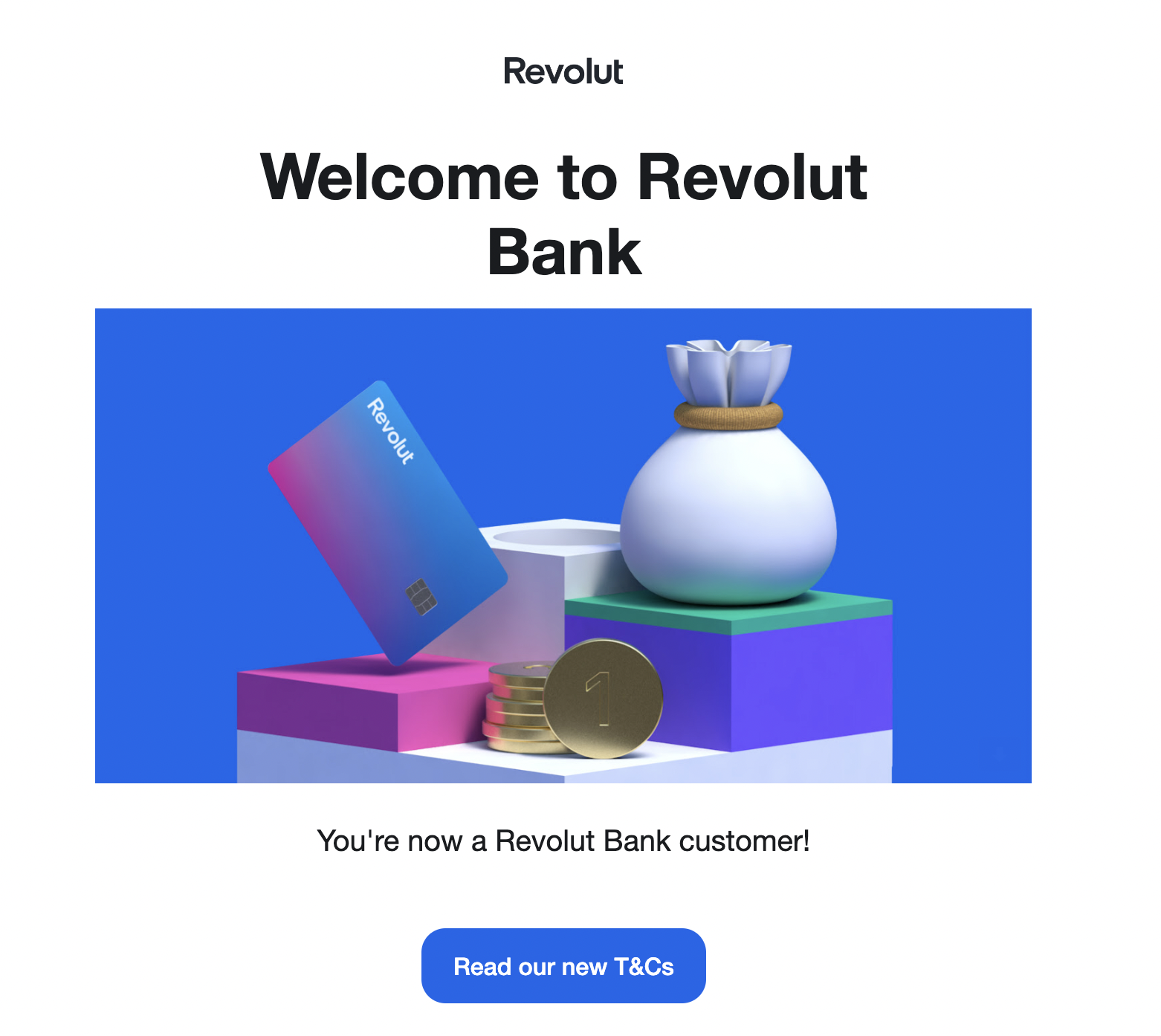
While many brands might choose to send a lengthy welcome email, Revolut opts for the short-and-sweet approach. They know full well that a new lead is not ready or willing to read a lengthy email, so they get straight to the point.
Furthermore, a simple greeting message followed by a CTA that nudges the customer to learn something is a great way to establish contact. You can use this approach for your welcome email series when creating a personalized email copy.
By the way, personalization is important when it comes to first contacts like these. So make sure to:
- Segment your recipients to make sure each of them receives an email with the right intent
- Address the recipient by their name
- Thank them for signing up
- Incentivize them to complete a specific action
You can also create a CTA that leads them to your Story page, About Us page, or even your case studies if you want to showcase your work!
Type #2: Updates announcements
Company, software, and product updates, changes to your brand, or anything that may affect your customers—you need to put it in an email.
These are important announcements that you’re obligated to communicate promptly if they directly or indirectly affect your customers.
A clear example of an update announcement comes from Google. At some point, all of us have received one of their Google Play Terms of Service updates:
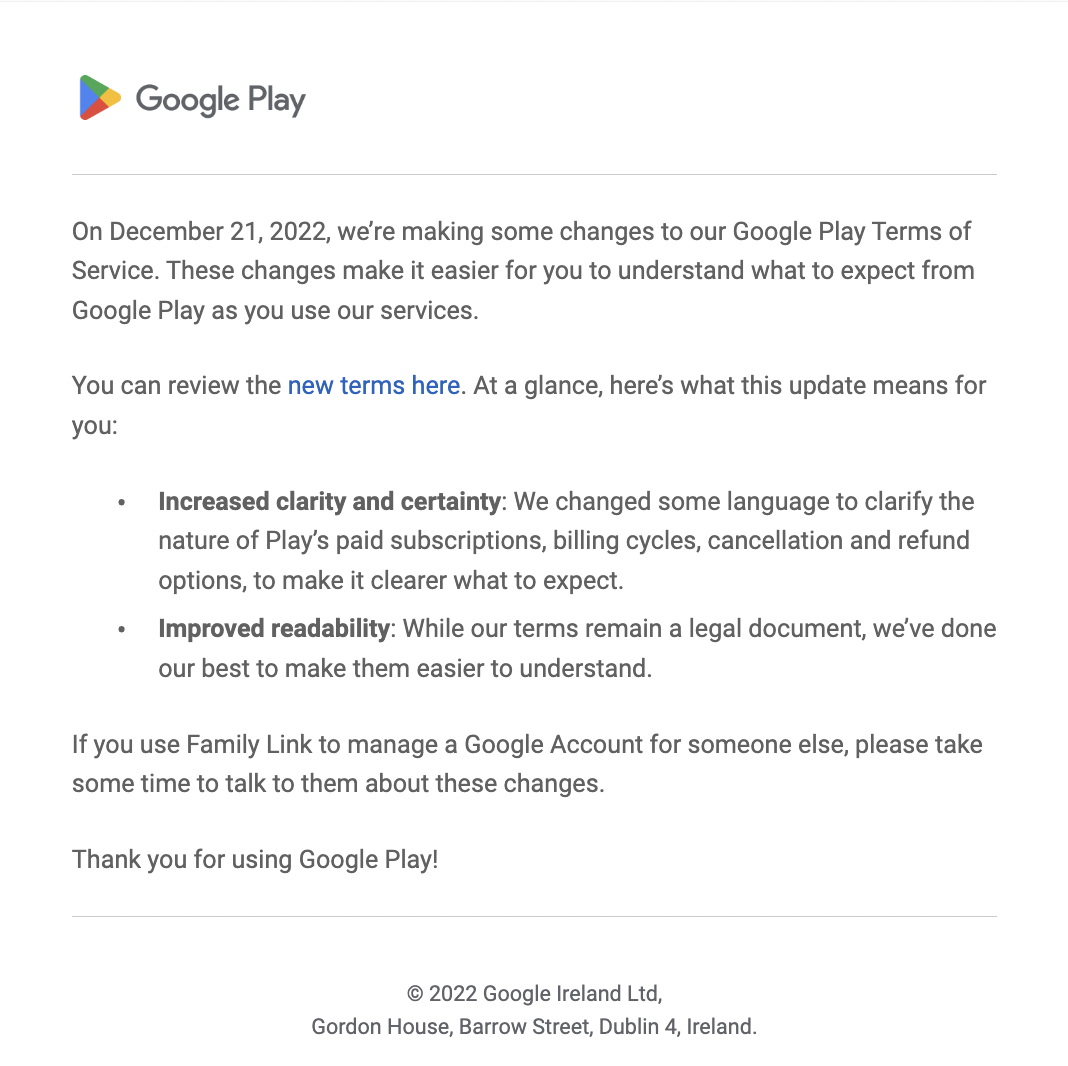
This service update from Google is a great example because of several key elements:
- Brevity and simplicity
- Copy structure and messaging
- Email formatting and information provided
- Link placement
If you take a closer look at the image, you will notice that the copy is clear and to the point, immediately establishing what the email is about. Next is a one-sentence explanation of why the changes are taking place.
Then, we have the only link the recipient needs to get all the information about these changes. It’s also important to list these at a glance before ending the email with any other important piece of information and a sign-off message.
You can use this exact structure to send out effective updates announcements yourself, but we urge you to take a look at our guide on how to format an email to truly maximize its potential!
Type #3: Newsletters
A newsletter is typically the cornerstone of a winning email marketing strategy, if for no other reason than to keep your brand present and relevant to your audience.
But it can be so much more.
An email newsletter is one of the most powerful marketing tools to build a more meaningful relationship with your customers. Because it takes on a more educative role, you can not only use it to stay top-of-mind but also to nurture new subscribers and long-term customers.
For instance, you can stay at the forefront of your customers’ attention by talking about your brand and its values and how they resonate with the values of your customers.
Another option is to talk about your latest projects and how they benefit something more important, such as a common cause you can share with the customer.
In fact, using the newsletter format to involve customers in a specific action is one of the best ways to maximize its value.
Here’s how Sifted does it with a mix of great email content and a clear call-to-action while putting some faces behind the messaging:

In this example, Sifted blended two goals, two distinct needs, into one compelling, rewarding email – asking recipients to share their thoughts and predictions by having them take a short survey and acknowledging these responses in an upcoming article.
This example provides an amazing format you can copy for your own email marketing efforts, just don’t forget to tell people how to unsubscribe in the footer.
Okay, now’s the time to talk about promotional emails and their place in your email marketing strategy.
Promotional Emails
A promotional email is geared towards sales enablement and improving conversion rates. These are the emails you send to incentivize new and existing customers to act, opening cross-sell and up-sell opportunities in the process.
These opportunities may manifest through promotions, special deals, discount codes, product launches, and more. We’ll go in-depth about these and the kind of CTA, messaging, and formatting that work best.
In a nutshell, promotional emails are there to guide leads through your sales funnel through sales-oriented messaging. Your basic sales funnel and email marketing funnel will have the same stages:
- Awareness
- Consideration
- Conversion
- Loyalty
A promotional email can sit anywhere but the Awareness stage, depending on the micro-stage of the funnel. A micro-stage is a transitory position in the funnel, such as when a lead is on the cusp of moving from Consideration to Conversion.
Even if they are not in the Conversion stage yet, you can start incentivizing them with “soft promotions,” for example.
Let’s break down the types of promotional emails for these stages.
Type #4: Sales promotions
Sales not only drive, well, sales, but they also affect the recipient’s mindset. Launching regular sales puts the idea into customers’ minds that your brand always has great deals on offer and that they should check back regularly.
Sending out promotional emails is as easy as coming up with a special offer and a coupon, but it’s a good idea to time it around a holiday or an important date—such as a Black Friday event.
Here’s an example of a clean sales promotion email from Wix:
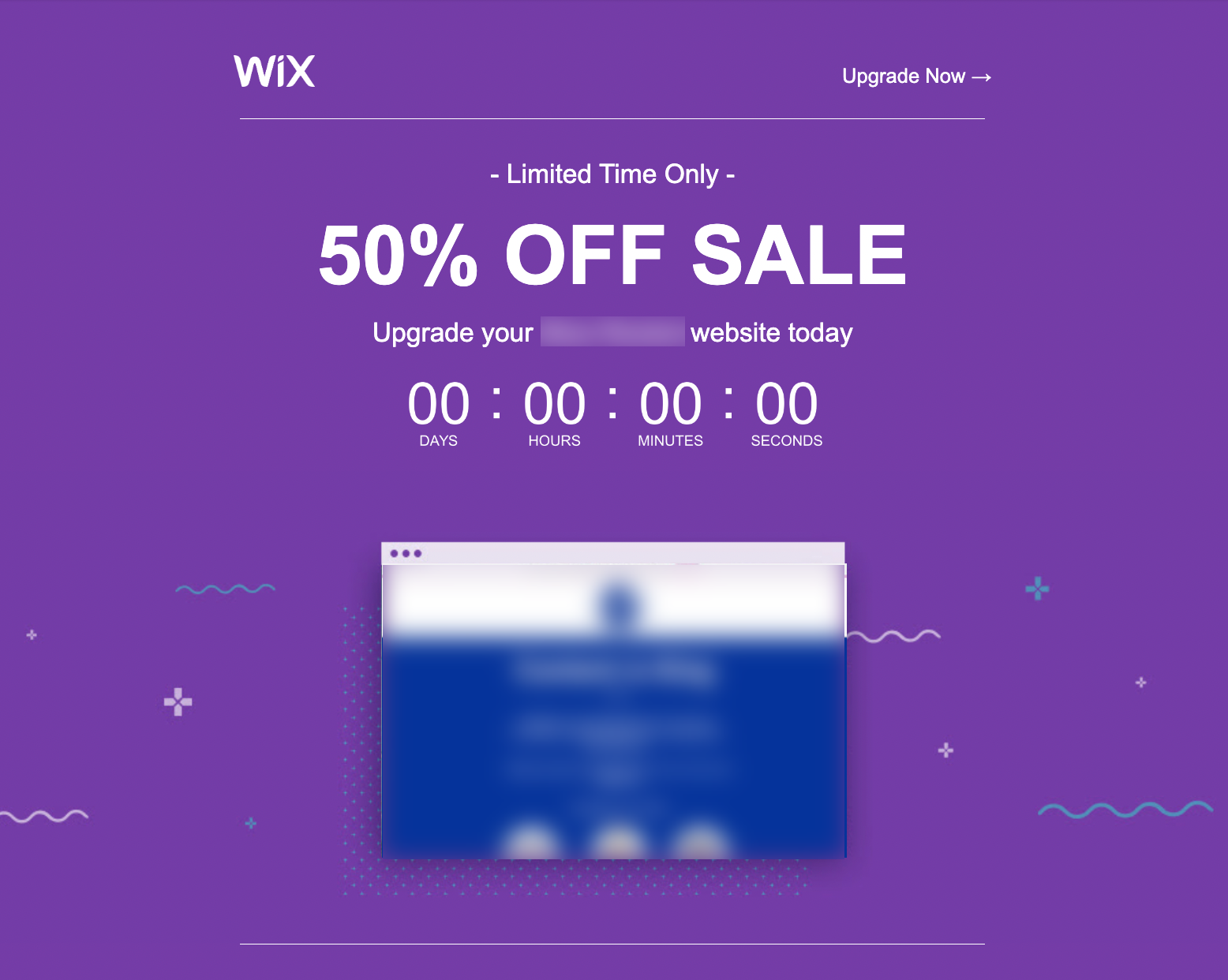
This offer is only valid for a limited time, perfectly displayed with a countdown timer to help create that FOMO (fear of missing out) effect.
Aside from having a timer or an inventory counter, you need to personalize your messaging. Speak to the recipient directly and give them a reason to act now.
Also, make sure you know the best time to send an email to different customer segments based on their location, purchase history, and online behavior.
Consider having a pre-sale announcement as well, hinting at the sale and when it goes live to prep your customers for the big day. This preparation will give them time to peruse your website, find something they like, and then wait for the sale to be live—all the time thinking it was their idea.
Type #5: Product launches
A product launch is a big deal for any small business, and email is one of the best marketing tools to announce the event.
A product launch generates buzz for your brand, which is why it’s a great idea to have a pre-launch campaign.
By teasing the launch of a new product or service, you can grow your email list on other platforms, like social media, by having people sign up to get updated when it’s live. Essentially, you can use it as a lead magnet.
Here’s how Casper introduced its new mattress product with customer feedback and sleep science:
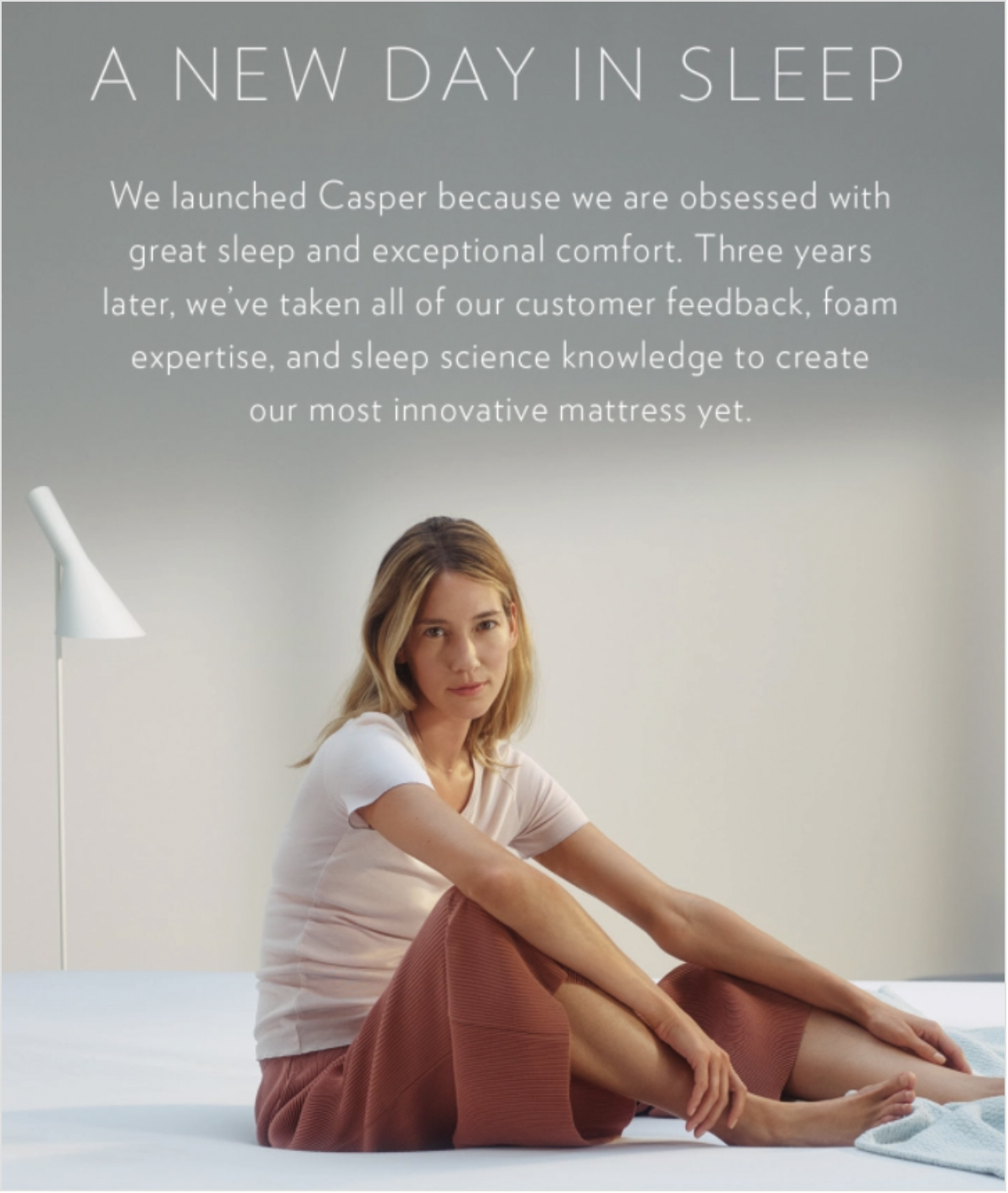
In this example, we can see a clear focus on quality copywriting and a compelling tone of voice. It’s also important to have a strong subject line without spam trigger words.
When launching a new product, you need to build a convincing narrative to answer the what, how, and why.
- What is the new product?
- How did it come about?
- Why should your customers care?
Start by introducing the reader to your story, then quickly answer these questions. Finish with a clear call-to-action that leads them to new product landing pages.
Type #6: Giveaways
A giveaway is another great way to spark engagement with your existing customers and incentivize purchases. You can also use it as a lead magnet on other platforms, such as LinkedIn or Facebook.
The key is to offer something truly valuable to your customers to incentivize them to enter a prize draw.
In this case, captivating visuals complemented by a clear value proposition are a winning combo. Here’s how Esqido did it:
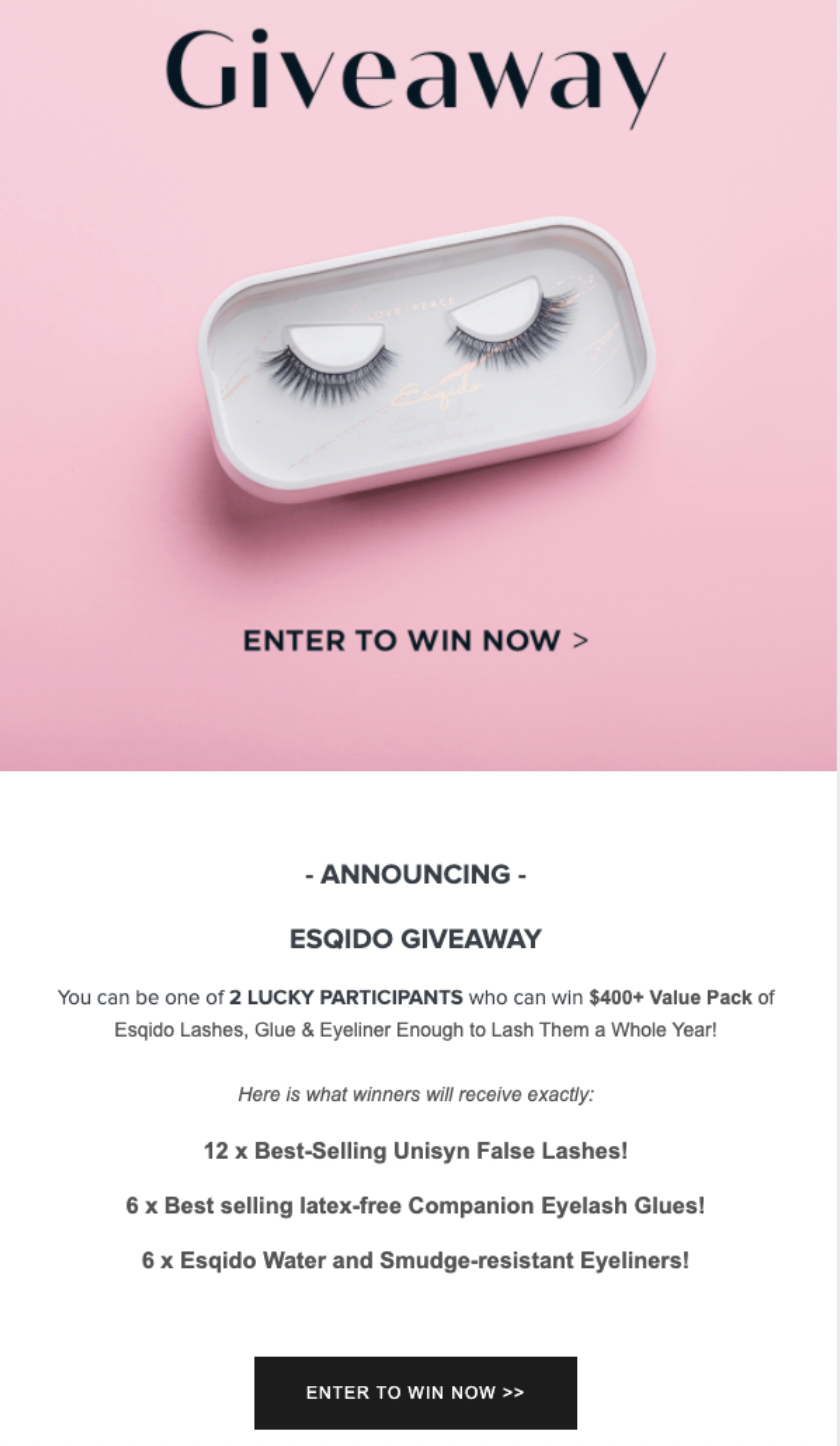
A compelling, clickable image followed by a short description of the giveaway is all you need to get people to enter.
By the way, a giveaway produces plenty of customer data to feed your email marketing metrics and allows you to improve customer retention.
Type #7: Seasonal campaigns
Seasonal email marketing campaigns can oftentimes propel businesses forward, so you should always capitalize on seasonal events.
You can plan these a whole year in advance if you know exactly what you’ll be offering. This forethought will give you plenty of time to nail the layout and personalize the messaging.
A popular blockchain game, The Sandbox, is a great example of a Halloween email done right:
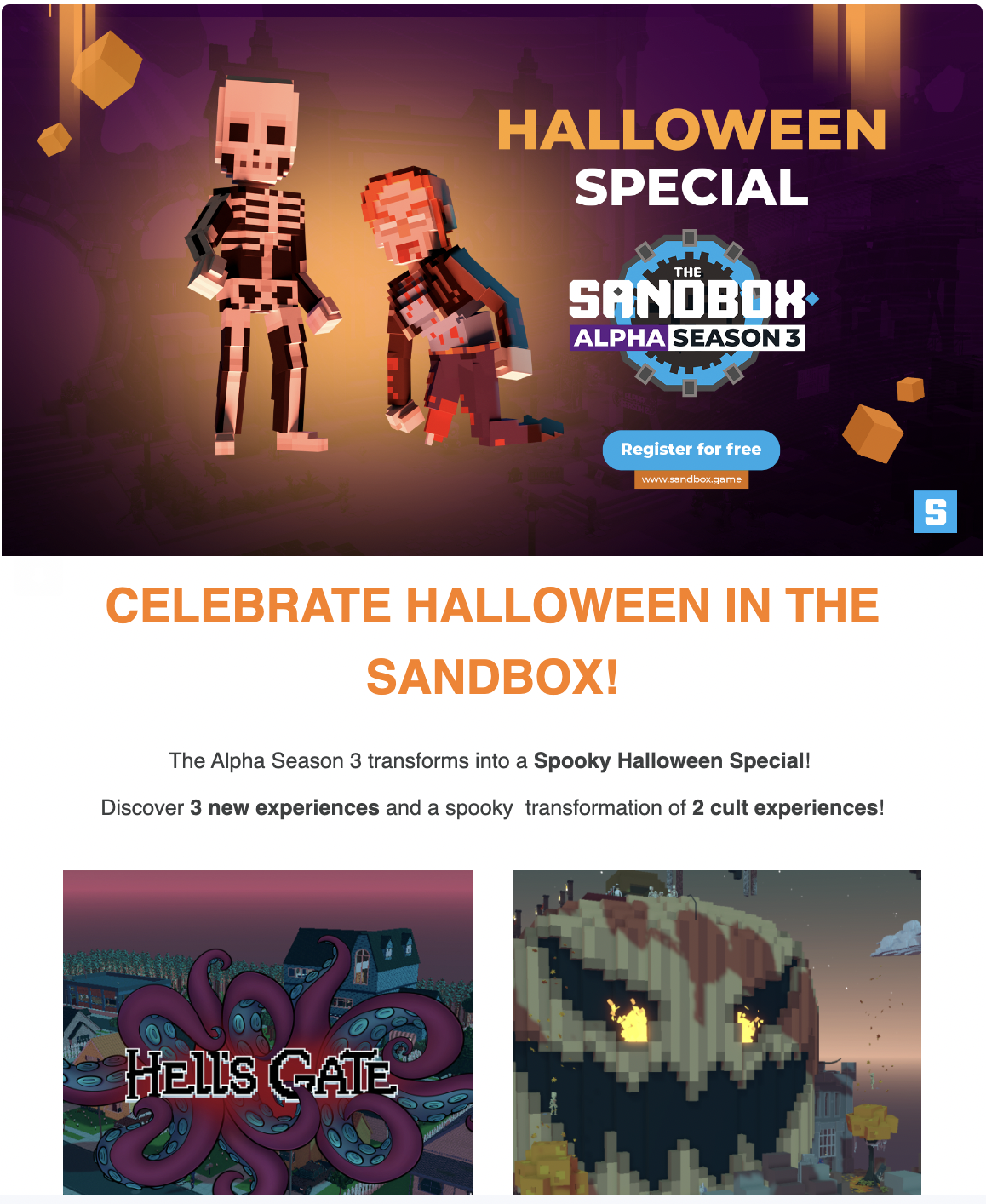
Adding spooky visual elements and updating the brand for a Halloween-themed event gives the email a fresh, engaging look. Clear and value-driven messaging is also essential, of course, with a CTA that can serve many purposes.
Besides, your seasonal email can be an invitation to a community-building event.
You can use seasonal emails for effective event marketing, inviting people to online events or a webinar you have organized specifically to capitalize on the season and its important events.
Type #8: Referral campaigns
Referral marketing can bring in a lot of money and a lot of new customers. In fact, according to AnnexCloud, referred customers bring a 25% higher profit margin!
Email marketing plays a key role in this case – you will need to send referral emails to promote your campaign and boost its ROI.
Again, Revolut does a stand-up job here. Here’s an example of their referral email:
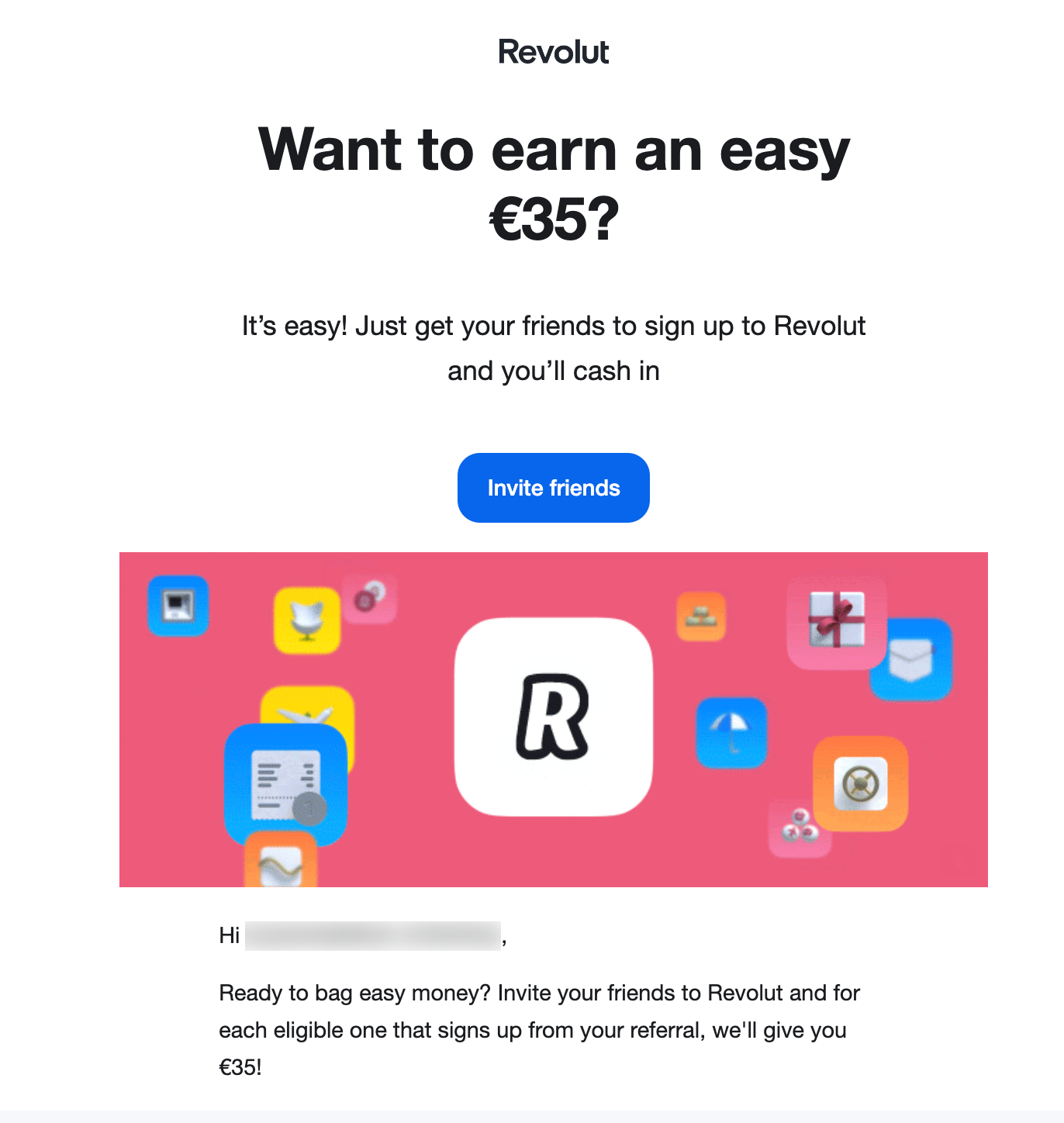
This example proves that a good email should start with a powerful, value-driven statement. The key is to quickly move into a short explainer and then immediately present a clear CTA button.
This combination is your above-the-fold content. After that, you can move into the personalized message, like in the example above.
Type #9: Product updates
Product updates, like general business updates, are essential for brand-customer transparency and trust.
Whenever you bring something new to your products and services, you need to round up the key changes in a personalized email.
Take a look at how Notion did this in the example below:
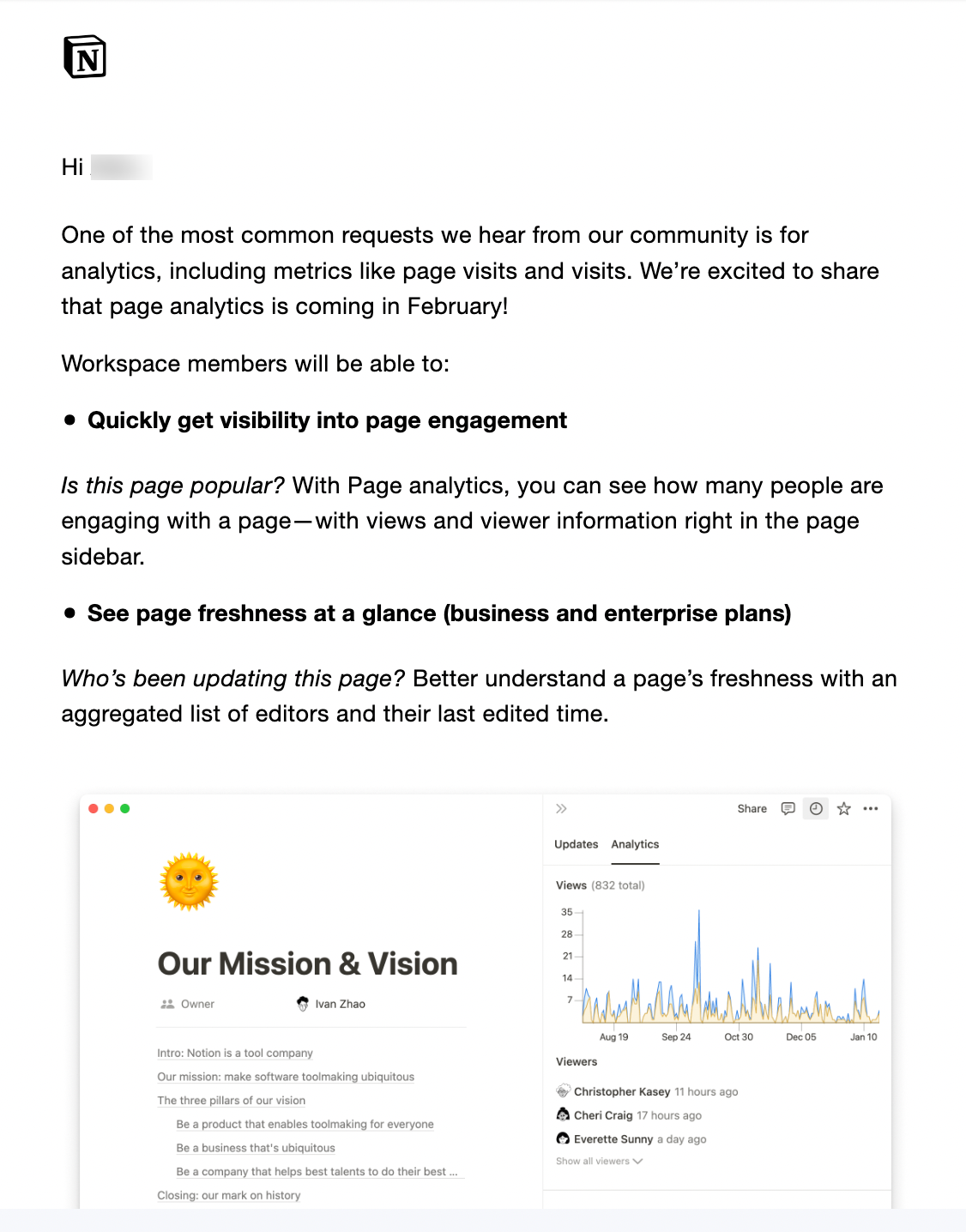
In this example, Notion starts by clearly outlining a previous problem and a need voiced by the community.
The email quickly tells the reader when the update will be live and then goes into a short overview of the key changes.
In B2B email marketing and also B2C, it’s important to follow a similar structure and make product announcements short while providing enough information about the upcoming changes.
Let’s wrap things up by looking at transactional emails and how they fit into your email marketing strategy.
Transactional Emails
Transactional emails are trigger emails that email marketing tools send to recipients upon completing an action. This transaction can be anything from a successful purchase to account activation or a password reset.
It’s interesting to note that, according to Outgrow, transnational emails have an average CTR of 4.8%. Good click-through rates like this show just how important this email type is for modern businesses.
Transactional emails are also a foundational part of marketing automation. You can send a series of emails when a customer engages with your brand and completes a specific action to guide them on their journey. This email type is essential for an effective email strategy that gives customers an overview of every interaction with your brand.
Let’s take a look at what these are and how you can use them.
Type #10: Signup/purchase confirmation emails
Order confirmations give customers peace of mind and an overview of their purchase, along with additional information about shipping, expected delivery, FAQs, and customer service.
Here’s an example of a purchase confirmation email from Fitbit:
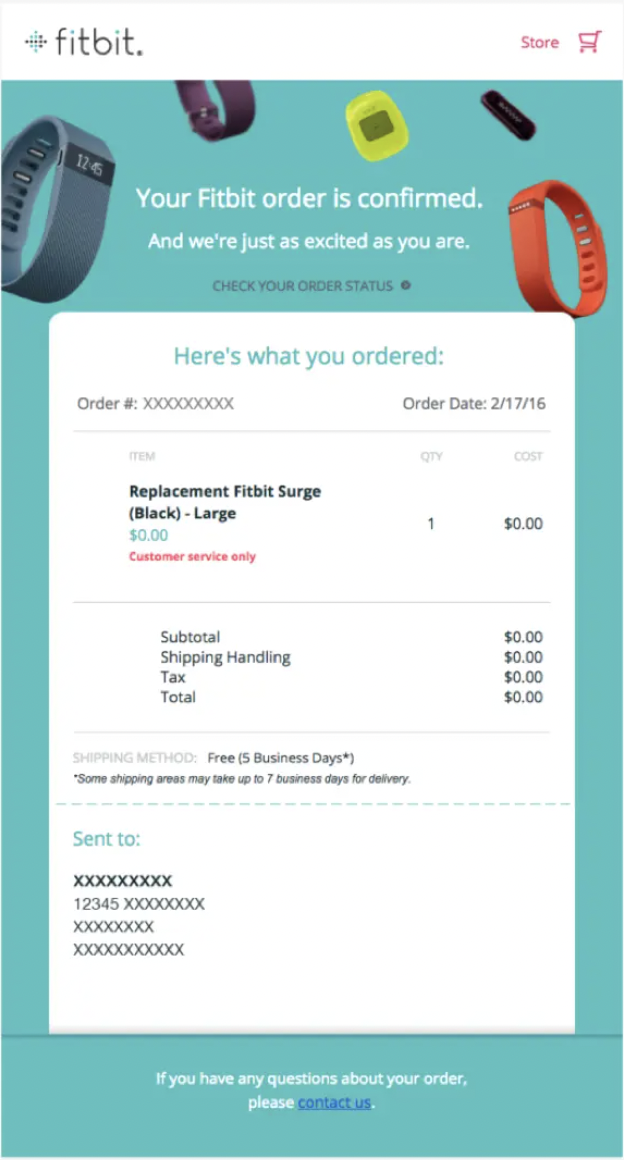
Aside from including your brand colors and visuals, you need to provide all the information about the purchase and attach a downloadable receipt.
The same rules apply if the customer has signed up for a service or a software product, but you should also add links to your user guides. This approach will kick-start a smooth onboarding process.
Type #11: Password resets
A password reset email is a set of instructions you send to a customer when they want to change their password. The instructions need to be clear and safeguard the customer’s personal information.
The password reset email from Treehouse is a good example of a straightforward process with additional info:

As you can see, the recipient is immediately greeted by a clear set of instructions to reset their password. The email also provides a separate URL that the customer can follow if the link above doesn’t work.
Treehouse also makes sure to provide continuous support by allowing the customer to reply to the email or write them an email if they have any questions. Without a doubt, this is one of the best email templates to use for this specific purpose.
Type #12: Re-engagement emails
Sometimes, people just fall off the bandwagon after a while; they stop using your service or never come back to purchase another product.
That doesn’t mean you should just let them wander off for good. Sometimes, they just need a good re-engagement campaign to remind them that you’re still here and have something truly valuable on offer.
Other times, a re-engagement email is actually a cart abandonment email for when customers leave items in their shopping cart without completing a purchase. This email type is essential for ecommerce businesses.
Here’s an example from Bonobos and how the company structures abandoned cart emails:
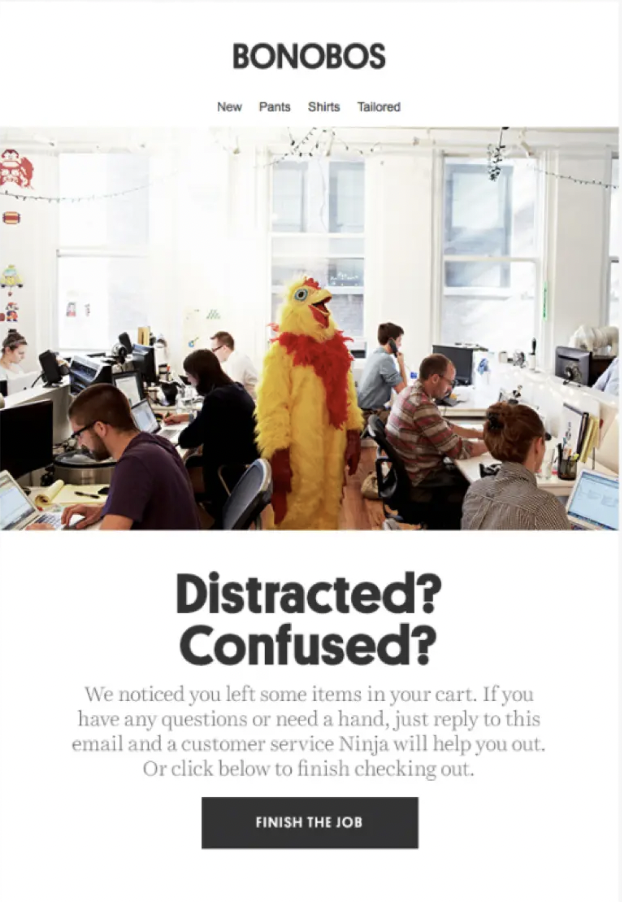
In this example, we see that the email starts with a whimsical image that aims to spark a positive reaction right off the bat. After putting a customer in a better mood and grabbing their attention, the email tells the recipient to reach out if they have any questions.
It then gives them a clear CTA button that will lead them straight to their cart to finish their purchase. You can, of course, follow up after a while if the first email is unsuccessful.
And with that, we can wrap up this guide knowing that you have all the different types of email necessary to take your email marketing forward in 2023.
Now Over to You
Without a doubt, investing in a robust email marketing strategy is one of the best ways to maximize your marketing dollars.
Now that you know about the different types of email you can use to maximize your marketing potential, go ahead and include these in your strategy moving forward. We promise that the rewards will far outweigh the initial investment.
If you’d like to learn more about email marketing and ramp up your digital marketing strategy in the process, check out our blog for more!

Nick Sekulic is a seasoned brand developer, a writer, and a storyteller, having worked on various marketing, branding and copywriting projects – crafting plans and strategies, writing creative online and offline content, and making ideas happen.
